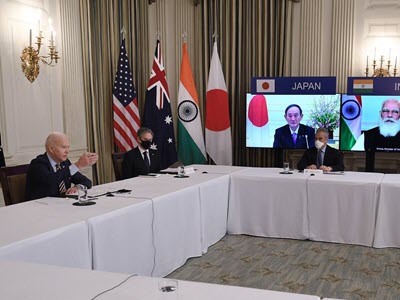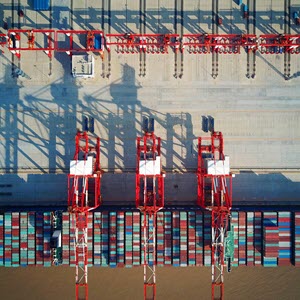Commentary from the Center for Innovation, Trade, and Strategy
U.S. Economic Statecraft 2.0 for Resilient Supply Chains in the Indo-Pacific
Hiroyuki Suzuki argues that the United States must strengthen supply chains by building a new version of economic statecraft, based on close dialogue between the public and private sectors, that can mobilize private capital in a coordinated approach and advocates for cooperation with allies.
As globalization has accelerated, global supply chains have prioritized efficiency ahead of resilience. However, the Covid-19 pandemic and U.S.-China trade frictions have pushed restructuring global supply chains to the top of the policy agenda. Companies are considering options to move production closer to markets and to diversify beyond China, while the U.S. and Chinese governments are taking steps to protect their own industries and improve their competitiveness. The risk to companies of being dragged into the U.S.-China trade conflict is no longer unique to a small number of highly strategic firms but rather a common business risk among firms with ties to either country. Many U.S. companies are struggling with the dilemma between geopolitics and economics, and some are considering exiting the Chinese market due to concerns about U.S.-China tensions, despite the importance they place on that market.
While it is expected that there will be a move to reorient supply chains toward allied countries in light of this geopolitical risk, it is not appropriate to leave the restructuring of supply chains solely to the private sector. The most urgent challenge for the United States is to strengthen supply chains by building a new version of economic statecraft, based on close dialogue between the public and private sectors, that can mobilize private capital in a coordinated approach. In this context, cooperation with allies—especially Japan, whose domestic industries are characterized by strong public-private collaboration—would provide a significant tailwind for the United States.
COVID-19 PUSHES FORWARD SUPPLY CHAIN RESTRUCTURING
In line with the major trend of globalization in recent decades, companies—both multinational and local—have made efficiency the central focus of their supply chains. However, multinational companies began to re-evaluate their supply chains in 2018–19 for a host of reasons, including the rising cost of labor in emerging markets and China, increased tariffs and geopolitical uncertainty, and a tide of protectionist policies in the United States. While many companies made news with their decisions to relocate manufacturing operations out of China as a consequence of the Covid-19 pandemic, this was only an acceleration of a preexisting shift toward Vietnam and Mexico. Growing recognition of the impact of supply chain disruptions on essential goods such as medical equipment, as well as on social infrastructure, provided a further impetus for policies to mitigate these risks and protect citizens’ livelihoods in a highly uncertain environment.
“The size of many companies’ manufacturing bases in China is so large that short-term substitution out of the country would not be easy even under optimal circumstances, much less during a pandemic.”
Achieving resilient supply chains requires a multifaceted approach and will take time; as such, a long-term view is needed. The size of many companies’ manufacturing bases in China is so large that short-term substitution out of the country would not be easy even under optimal circumstances, much less during a pandemic. In addition to the unavoidable restrictions on corporate activities—such as international interactions necessary to establish new supply networks—companies damaged financially by the Covid-19 pandemic have limited resources to make swift, large-scale investments that will drastically change their supply chains.
STRATEGIC RIVALRY BETWEEN THE UNITED STATES AND CHINA PUSHING FOR SUPPLY CHAIN RESTRUCTURING
In mid-July, the Biden administration issued two advisories aimed at the U.S. business community—the “Xinjiang Supply Chain Business Advisory” (Xinjiang Advisory) and the “Hong Kong Business Advisory” (Hong Kong Advisory). The Xinjiang Advisory points out the widespread use of forced labor in the Xinjiang Uighur Autonomous Region and warns that companies and individuals who do not withdraw from supply chains, joint ventures, and investments related to Xinjiang risk violating U.S. laws against forced labor. The Hong Kong Advisory cautions that China’s introduction of regulations such as last year’s Hong Kong National Security Law have increased risks and that companies should be aware of the potential reputational, regulatory, financial, and legal risks associated with doing business in Hong Kong.
China, recognizing Xinjiang and Hong Kong as part of its “core interests,” responded that forced labor did not exist, that U.S. accusations were a pretext for attacking China, and that increased IPOs in Hong Kong demonstrated that political risks were not rising. Furthermore, it warned that any sanctions against China would be met with a reciprocal response by the Anti-Foreign Sanctions Law, which was passed and put into effect by the Standing Committee of the National People’s Congress in June. On the other hand, the U.S. Hong Kong Advisory, acknowledging that China’s Anti-Foreign Sanctions Law increases business risks for U.S. companies, warns that failure to comply with U.S. sanctions will result in grave penalties under U.S. law, making it clear that the United States has no intention of relaxing its sanctions toward China.
In this way, neither the U.S. nor the Chinese government has stepped back, and both have clearly indicated their positions to the private sector, encouraging companies to take the initiative in unwinding supply chain risks and forcing stakeholders in the private sector to make decisions by themselves. Companies have had to recognize this as a reality. But another reality is that they are torn between the economic appeal of the Chinese market and the associated geopolitical risk. On August 5, the U.S.-China Business Council released a report summarizing the results of a survey of its member companies. Although more and more companies are expressing concern about the stability of their business due to growing U.S.-China tensions, they continue to emphasize the Chinese market. The conflict between these two factors will plague the industrial world for the foreseeable future.
TOWARD U.S. ECONOMIC STATECRAFT 2.0
Leaving all supply chain restructuring to private business, however, is not appropriate. Instead, it is necessary to formulate a new version of economic statecraft (which I call Economic Statecraft 2.0) based on the premise of dialogue between the public and private sectors. The United States has always used economic statecraft such as financial sanctions, export controls, and development assistance. Yet the vitality of the private sector, which is a U.S. strength, has not been well-coordinated with government initiatives. In the current geoeconomic environment, collaboration between the two sectors will become more important. In this regard, the recent efforts by Japanese government and policy-based financial institutions, which have long been building foreign economic policies based on close dialogue between the public and private sectors, should serve as a frame of reference for the United States.
For example, to strengthen the global supply chains of Japanese companies, the Japanese government is providing support for businesses to improve domestic production systems and diversify overly concentrated production in China to new locations such as Japan, members of the Association of Southeast Asian Nations (ASEAN), and other countries. The Ministry of Economy, Trade and Industry has established subsidies for projects that promote domestic investment in supply chain measures, as well as for projects that diversify overseas supply chains. The Japan Bank for International Cooperation (JBIC), Japan’s policy-based development financial institution (DFI), initiated the “post-Covid-19 growth facility” (Supply Chain Resilience Enhancement Window) in January 2021. This initiative supports Japanese companies recovering from economic and supply chain disruptions resulting from the Covid-19 pandemic. JBIC has a cooperative relationship with the U.S. International Development Finance Corporation, and this platform has developed into trilateral cooperation between the United States, Japan, and Australia. Thus, it is expected that DFI collaboration between the United States and Japan, together with other allies, will support the United States’ development of Economic Statecraft 2.0.
“As supply chain restructuring continues, and new government-to-government frameworks emerge, the Indo-Pacific region will be a major battleground for private stakeholders seeking to establish more resilient supply chains…”
JBIC has also been promoting infrastructure cooperation in the Indo-Pacific region. In January 2021, for example, it worked with the United States and Australia to provide financial support for a submarine cable project for Palau. This cooperation should be extended from infrastructure to establishing resilient supply chains. The four Quad countries (the United States, Japan, Australia, and India) agreed to launch the Quad Critical and Emerging Technology Working Group at the March 2021 summit. In April 2021 the governments of Japan and the United States agreed to launch the U.S.-Japan Competitiveness and Resilience (CoRe) Partnership. In this way, a platform for intergovernmental supply chain cooperation is being created. Under these initiatives, JBIC and the U.S. International Development Finance Corporation are expected to cooperate regarding the further mobilization of private capital. As supply chain restructuring continues, and new government-to-government frameworks emerge, the Indo-Pacific region will be a major battleground for private stakeholders seeking to establish more resilient supply chains, as represented by healthcare value chains and high-tech industries such as semiconductors.
In light of the geopolitical tension between the United States and China, European countries are also making strategic moves. From the perspective of diversifying its heavy economic dependence on China, Europe is hedging to strengthen trade and investment relations with other Indo-Pacific countries. For European industries, capturing demand from the Indo-Pacific region is becoming an urgent challenge. The United Kingdom has demonstrated interest in joining the Japan-led Comprehensive and Progressive Agreement for Trans-Pacific Partnership (CPTPP) and announced an “Indo-Pacific tilt.” The latter initiative aligns with the country’s post-Brexit aspiration for a “global Britain” by diversifying trade and security relationships with the Indo-Pacific. Other European countries, including Germany and France, have also established diplomatic guidelines for the region. Furthermore, in September 2021, the European Union announced its new Indo-Pacific strategy, “The EU Strategy for Cooperation in the Indo-Pacific.” In the future, European companies are expected to join the movement to restructure supply chains in the region and strategically align supply chains among allies.
There are numerous and complex connections between companies in global supply chains. Therefore, the process of recovering from the Covid-19 pandemic is a critical time for companies, governments, and government agencies to work to strengthen supply chains, especially in developing countries. The United States needs to play a leading role in realizing a trade and investment environment that is free, fair, inclusive, transparent, and stable. In the development of a new version of economic statecraft to mobilize private capital, cooperation with Japan—which has many years of relevant experience—would be beneficial for the United States.
Hiroyuki Suzuki is Chief Representative of the Washington Office at the Japan Bank for International Cooperation (JBIC). He is also a Visiting Fellow of the Japan Chair at the Center for Strategic and International Studies. All views, positions, and conclusions expressed in this commentary are solely those of the author.



